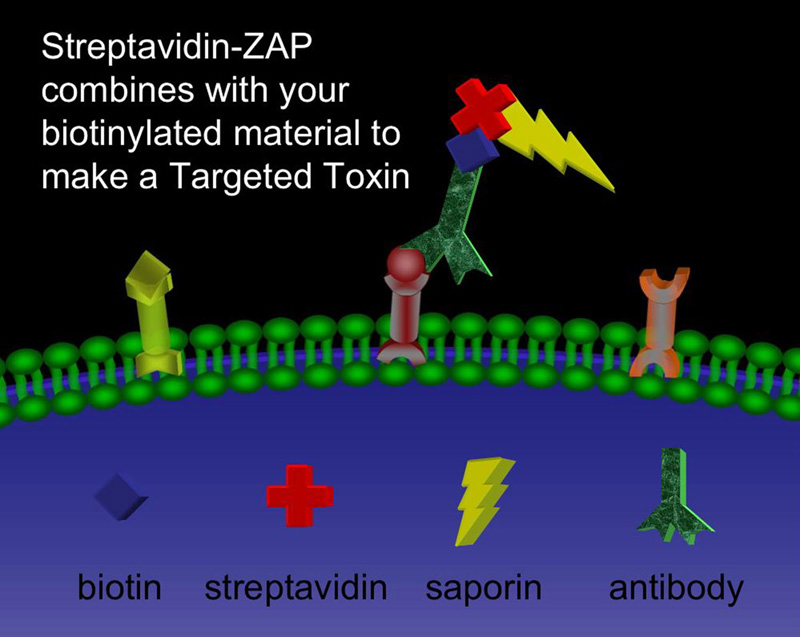Streptavidin-ZAP
[Streptavidin conjugated to Saporin]
(Cat. #IT-27)
Objective: To determine if an immunotoxin cocktail targeted to multiple epitopes has synergistic effects on low expression level cells, which would expand the applicable range of immunotoxin therapy for cancer.
Summary: The combination of immunotoxins with different mechanisms of action in an antibody cocktail will increase cytotoxic activities and decrease side effects.
Kusano-Arai O, Iwanari H, Kudo S, Kikuchi C, Yui A, Akiba H, Matsusaka K, Kaneda A, Fukayama M, Tsumoto K, & Hamakubo T. Synergistic Cytotoxic Effect on Gastric Cancer Cells of an Immunotoxin Cocktail in Which Antibodies Recognize Different Epitopes on Cdh17. (2018). Monoclonal Antibodies in Immunodiagnosis and Immunotherapy, 37 (1):1-11.
The authors applied a monoclonal antibody (mAb) cocktail for one target protein with multiple epitopes. They generated anti-CDH17 mAbs recognizing different epitopes on CDH17 (Cadherin-17). CDH17 is expressed in gastric cancer, hepatocellular carcinoma, colorectal cancer, and pancreatic cancer and has limited distribution in normal tissues. For preparation of 3 immunotoxins, Streptavidin-ZAP was mixed with biotinylated mAbs in equimolar concentrations for 30 minutes at room temperature.) The study provides data to demonstrate that the cocktail of different epitope-recognizing immunotoxins has synergistic cytotoxic effects on CDH17-expressing cells.
Streptavidin-ZAP (Cat. #IT-27)
Streptavidin-ZAP converts biotinylated materials into targeted toxins. Streptavidin is a tetrameric protein (molecular weight 53 kDa in its recombinant form), with each subunit able to bind a single biotin molecule. The bond between streptavidin and biotin is rapid and essentially non-reversible, unaffected by most extremes of pH, organic solvents, and denaturing reagents. It is the strongest known noncovalent biological interaction (Ka = 1015 M-1) between protein and ligand. The streptavidin used to make Streptavidin-ZAP contains no carbohydrate group and has a neutral isoelectric point, which therefore reduces the nonspecific binding as compared to avidin.
Turn your biotinylated antibody into an Immunotoxin!
A variety of molecules, including lectins, proteins, and antibodies, can be biotinylated and reacted with streptavidin-labeled probes or other detection reagents for use in biological assays.
Streptavidin-ZAP is also available in three kit variations: Z-kits (KIT-27-Z) include everything you need to perform in vitrointernalization assays with your biotinylated targeting agent. For in vivo assays, use KIT-27-A for antibodies and KIT-27-B for peptides.

